2023 WMS Elective Recap
Molly Enenbach, DO
Neelou Tabatabai, DO
What do you get when you combine 29 students and residents from Canada, Denmark, and the United States for several weeks in one cabin with bonfires, backpacking, and high-angle rescue? Yes, a lot of smelly laundry but also lifelong memories and friendships. The WMS 2023 Elective was just that.
Ten medical students and residents attended the four-week course, affectionately termed “four weekers”, where they became Wilderness First Responder (WFR) certified. During our first night as residents attending the two-week portion of the elective (“two weekers”), 19 of us arrived to the cabin in New Castle, VA, for journal club and a delicious dinner followed by moulage and a hike into the woods to become victims for the final scenario rescue for the WFR course. As we lay “wounded” in the forest, we were blown away by the efficiency and knowledge of the four weekers and their ability to command Hasty Teams of two weekers, people they had just met. The night concluded with the successful rescue of all patients in the cool February mist.
Over the next 1.5 weeks, the groups were immersed in interactive lectures, demonstrations, and skill sessions. Sessions varied and included high altitude and Gamow bags, land navigation skills, orthopedic injuries, animal attacks, wellness, drowning, swift water rescue, rope rescues, and women's health.
Along with medical knowledge, campfire cooking knowledge was also a must with the Annual WMS Chopped: Camping edition, where the competition was fierce and the food was on fire, both literally and metaphorically. Each team was given access to a camping stove or fire pit and a plethora of camp food supplies. Dishes were diverse: from potato pancakes to enchiladas, tacos to noodles, and stir fry to s’mores made from some unique ingredient choices. The best team won, but we won’t mention any names as they know who they are (and no, we're not still bitter at our loss).
After a successful night of cooking, many learners headed to the local Roanoke YMCA for an introductory scuba diving class where they learned basic etiquette, safety, equipment, and techniques from a divemaster. They had a swimmingly good time, to say the least, and no shark encounters were reported.
Back at camp, the groups headed to the climbing wall where climbing skills and safety were reviewed. For many, they learned the RADS (Rapid Ascent/Descent System) for the first time, scaling high above the treetops where they could see their next adventure and the vast beauty of the nearby Appalachian mountains. Before leaving the wall, the team, with expert guidance, performed their first successful high-angle rescue simulation. Shoutout to our awesome volunteer victim!
Although the rain had been abundant, the nearby river finally calmed and groups of residents piled into rafts while donning their very flattering dry suits. As we navigated the river, groups practiced swift water rescue, watched skillful pups swim the river with ease, and ended the day with a lively throw bag competition.
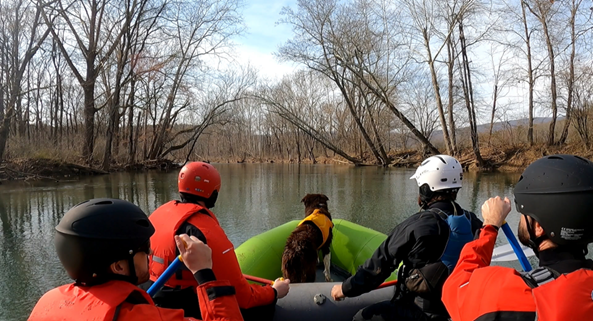
Photo Credit: Katie Kammert
After spending time swimming in the sun, it was time we headed into the darkness. We numbered off and headed into a spectacular cave where experienced instructors taught the basics of caving etiquette, safety, and rescue. We also got to experience how quiet and dark a cave really is. We turned off our lights and mindfully listened to the brisk water stream nearby. After crawling and weaving through tiny holes, one of our brave residents volunteered to be the patient needing rescue. Like well-organized ant colonies, we created lines, carrying our friend in the sked over our backs, across the floor, through tunnels, and to safety.
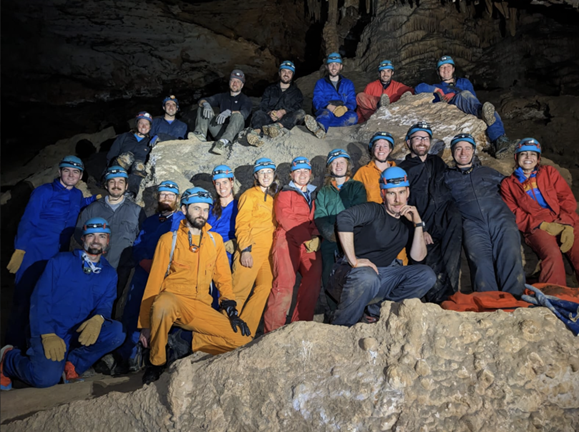
Photo Credit: Neelou Tabatabai
Before our time as a large group came to an end, learners created an epic Medwar for the State Patrol, DEA, and FBI. Residents were tasked with creating scenarios based on wilderness teaching points ranging from field amputation to altered mental status to low-angle rescue. The morning started off early with agents broken into teams, working their way through the course, and ended with elective learners and agents witnessing a simulated patient helicopter rescue. This event concluded our time as a large group at camp before breaking off into our smaller groups. The four weekers and around half of the two weekers planned their backpacking trips and set off for four days of adventure. Of the remaining two weekers, they all headed to Pilot Mountain for four days of technical rope rescue.
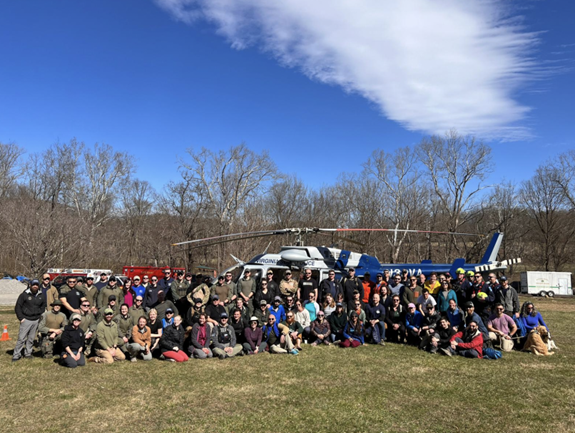
Photo Credit: Neelou Tabatabai
Pilot Mountain stood behind the beautiful Poplar Creek Farm, the home base for the technical rope rescue course. Tents sprawled across the farm with ropes and climbing equipment more abundant than people. The course started with pickoffs and belay takeover at a climbing gym with a tour of the city of Winston-Salem, where plenty of delicious bbq was eaten. Over the next few days, the team of residents learned and applied low-angle and high-angle technical rope rescue. On the final day, the team successfully executed a simulated high-angle rescue where they had to rescue a simulation dummy from a ledge, descending 90 feet down and back up.
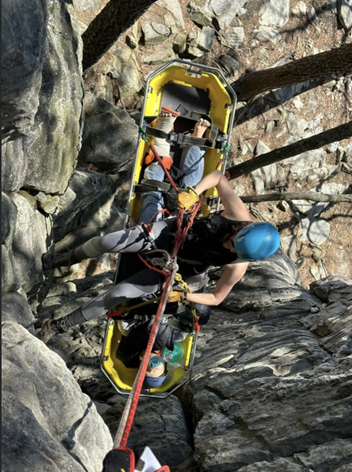
Photo Credit: Frank Marowitz
The backpacking trip was one of the options participants could choose to do. This was a 4 day, 3 night trip along the Appalachian mountains. About 10 of us were divided into two smaller groups with our backpacking leader, and we set off on our adventure! Before departing, each team did lots of trip planning including picking a route and planning meals. Both routes involved waterfalls, sweeping vista views, and no shortage of ever changing weather to keep you on your toes. On the second night, both groups met up in the middle of their respective routes. That night involved singing a song about camping bidets to the tune of Backstreet Boys “I Want It That Way” and creating the best campfire meals.
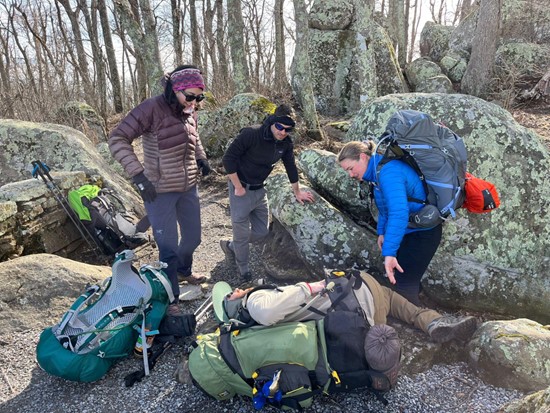
Photo Credit: Neelou Tabatabai
After the backpacking trip and technical rope rescue courses, the groups met back at the cabin, excited to all be in each other's company again for the closing banquet. Awards were given and a clever rendition of a popular John Denver song was performed by the four weekers. The night concluded with laughter, delicious food, story sharing, and a bonfire. As we all packed our things, a tribulation after repacking so many times, we all said our sad goodbyes but had joy in knowing we had made great friends and adventure mates that we would be seeing again. The WMS 2023 Elective taught us so many things, and the people we met there have become lifelong friends.
Wilderness Medicine Elective: An Adventurous Learning Experience
Karen Boisen, medical student
On a small slope, we suddenly see the patient and quickly divide into two teams: one in charge of patient care and the other in preparing for the extraction. The patient has a sucking chest wound, an open tibial fracture, and a possible hip fracture. We swiftly do the first assessment and place a tourniquet to control the bleeding of the lower extremity. We make a three-sided dressing to cover up the sucking chest wound, and one person takes charge on c-spine immobilization. Everybody is doing their part, and the group preparing for the extraction puts up an anchor and rope to attach to the litter. As soon as the patient is ready, we tip her onto the litter, secure her in place, and lower her carefully to the bottom of the slope where a small stream flows. Because of the difficulty of the terrain, we must pass the litter to the person in front of us instead of walking with the litter. This makes the extraction incredibly lengthy and complicated. To be honest, I have never really given much thought into how difficult it can be to extract patients from the backcountry, but after carrying a litter together with seven other people through 500 feet of shallow water, I now have an idea.
We worked surprisingly well as a team, and whenever there was a task to be done, everybody had their assigned role. For this particular search and rescue, I was assigned team leader. I had the opportunity to delegate and be in charge during the scenario, something that I have never really experienced during the past four years of medical school. This was an unexpected part of the Wilderness Medicine Society (WMS) elective but is an experience I think all medical students would benefit from. We as physicians are obligated to take leadership almost the minute we walk out of medical school, and it takes practice to become a good leader.
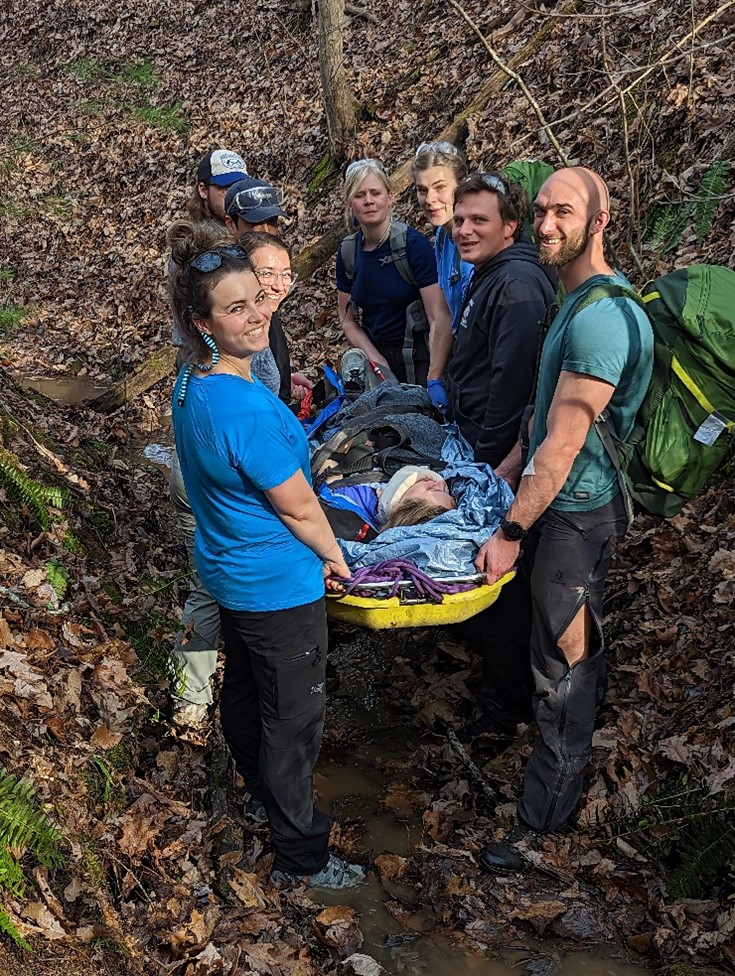
Photo credit: Kyle Brown
The WMS elective is a four week course held in the northwestern part of Virginia and teaches participants medical management in the many different wilderness environments through lectures and direct patient care scenarios. The elective is designed for medical, nursing and PA students, in addition to medical residents. The class takes place at Wilderness Adventure at Eagle Landing, which is what I would expect the perfect place for a summer camp to look like without ever having been to one.
Before arriving to the camp, I had many expectations, but not much knowledge regarding the actual content of the elective. Besides the short description on the WMS website, all I knew about the course was information that past students had shared with me. As the first evening began, our group began arriving: six Danes, including myself, three Americans and one Canadian. These were the team members I would spend the next 4 weeks with.
During the first couple of days, we had wilderness medicine introductory lectures and scenarios. We learned basic survival skills such as how to make a shelter, light a fire, and rope techniques to build anchors and use knots to lower a litter. All the things we learned became useful throughout the elective and, as many of the faculty taught us, the best kind of rescue is self-rescue, when possible.
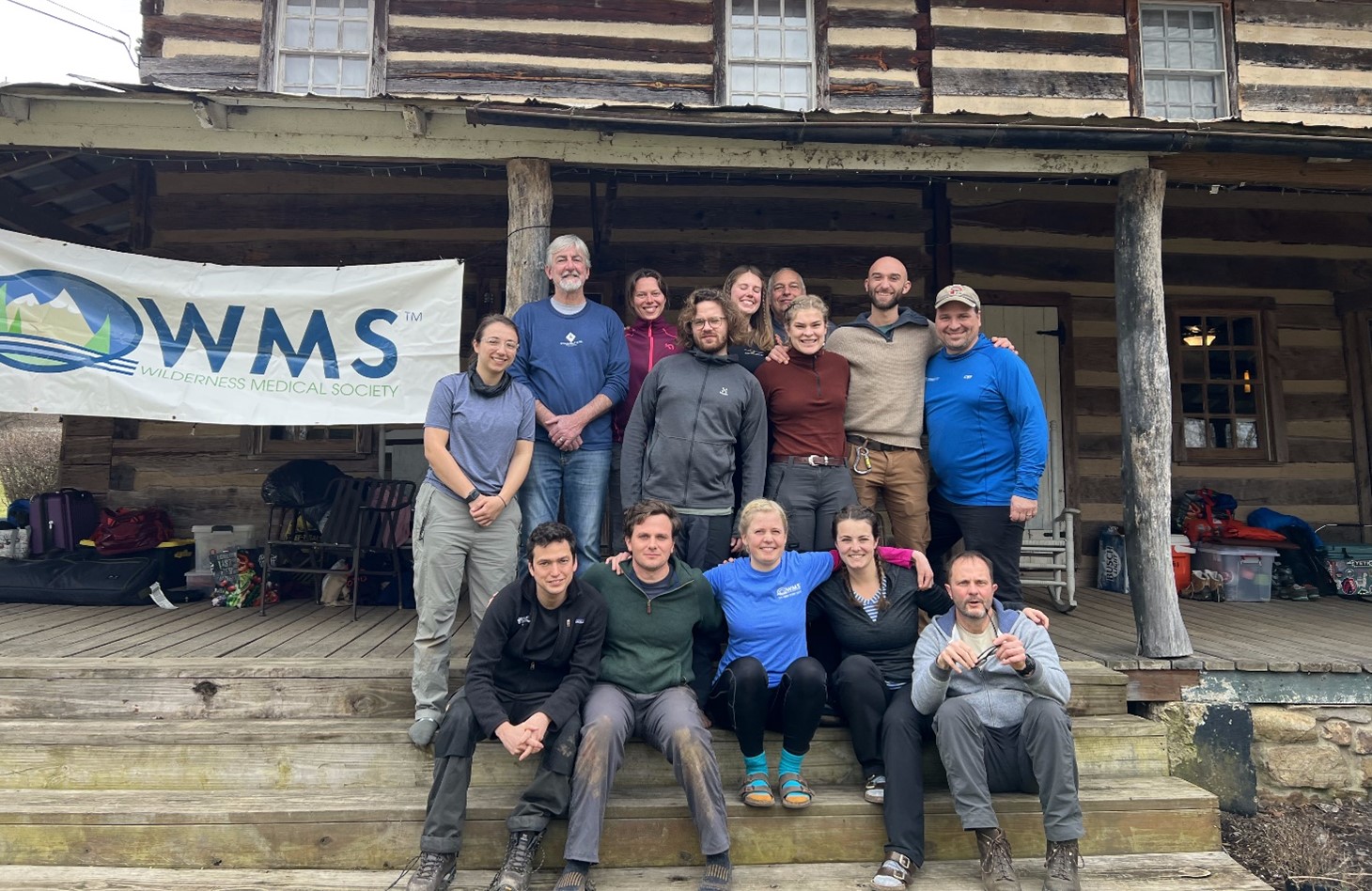
Photo credit: Kirk Harris
In our second week of classes our schedule read “WFR,” pronounced “woofer,” and which I later learned meant Wilderness First Responder. Early in the week we learned how to treat arterial bleeds, reduce fractures, how to perform a needle decompression and other practical skills which would become useful in later scenarios. The WFR class was led by flight paramedic Kirk Harris. Kirk told the most incredible stories about the things he had experienced through his career and in daily life. One thing he said, which I will always remember, is that wilderness medicine is not only about treating people in austere environments away from home, but also about how we use this knowledge to act as good neighbors and citizens within our community and our ability to react when we come across different medical emergencies.
After many medical scenarios throughout the week, the WFR course culminated with a night scenario where we had to do a search and rescue to find the victims of an airplane crash, treat them on the scene and extract them to a place where they could be picked up. I was in charge of the treatment team, and because we were not dispatched until the searching teams had located the place of the accident, we arrived after the triage and first assessment of the patients had been done. It was my job to collect all information about the patients and pass it on to our team leader. The darkness and the distance between the patients made it difficult to communicate, but once our team leader came to the scene, we used the gathered information to deliver the patients back to camp.
The WFR class taught me many things that I will continue using during my life as a medical student and after I graduate. Most importantly, it taught me how to stick to the basics and the importance of detailed and consistent communication.
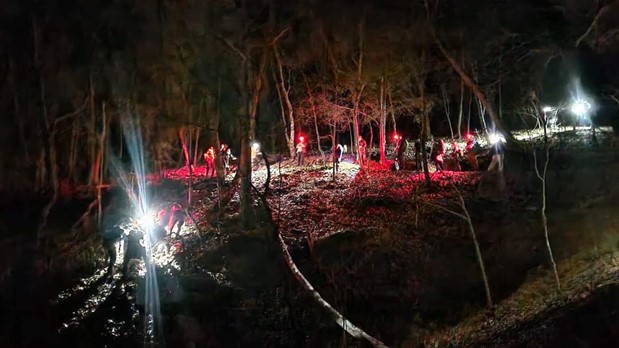
Photo credit: Kyle Brown
Even though the schedule was fairly busy, a major part of the elective was also the time spent outside of the planned lectures. Most nights were spent in front of the large fireplace outside, toasting marshmallows and having late night chats. It was a great way of getting to know students, residents and the instructors. On the weekends we went on hikes together to see the beautiful views of Virginia. We also had a couple of days in the city where we went to a cinema and to a restaurant. We did many things as a group, and I really enjoyed our adventures. I still miss having a large firepit in my backyard and being a bit more disconnected from the internet.
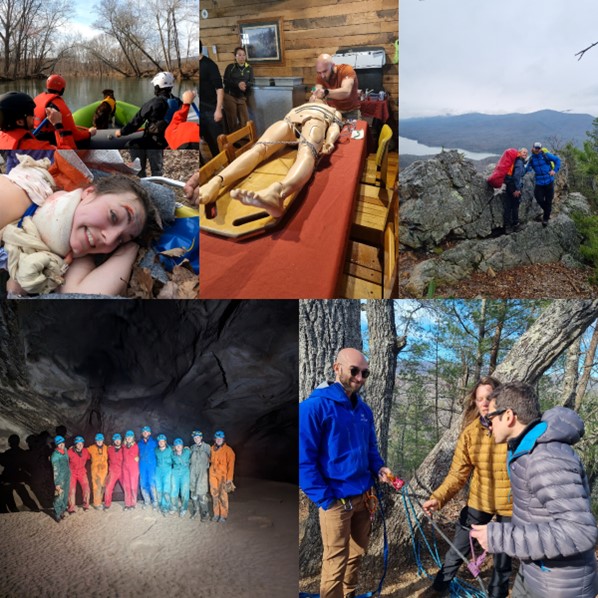
Photo credit: Carver Haines and Karen Boisen
The last four days of the elective we spent backpacking. Our group decided to hike a short piece of the Appalachian Trail (AT) called the Triple Crown. The hike has three of the most popular views of the AT in Virginia, and because this was our only chance to see all three of them, we decided to do that for our trip.
Our first day was damp and very foggy, and we could not see very far. Luckily, the rain stopped before we reached our campsite for the night. The next day the sky had cleared, and by the time we reached McAfee Knob the sky was completely blue. The views were beautiful, and we felt very blessed with the weather. On the last day we ended our trip with a sunrise on top of Dragon’s Tooth, another viewpoint just off the AT. It felt like a perfect ending, like being rebooted before having to return to daily life as a medical student.
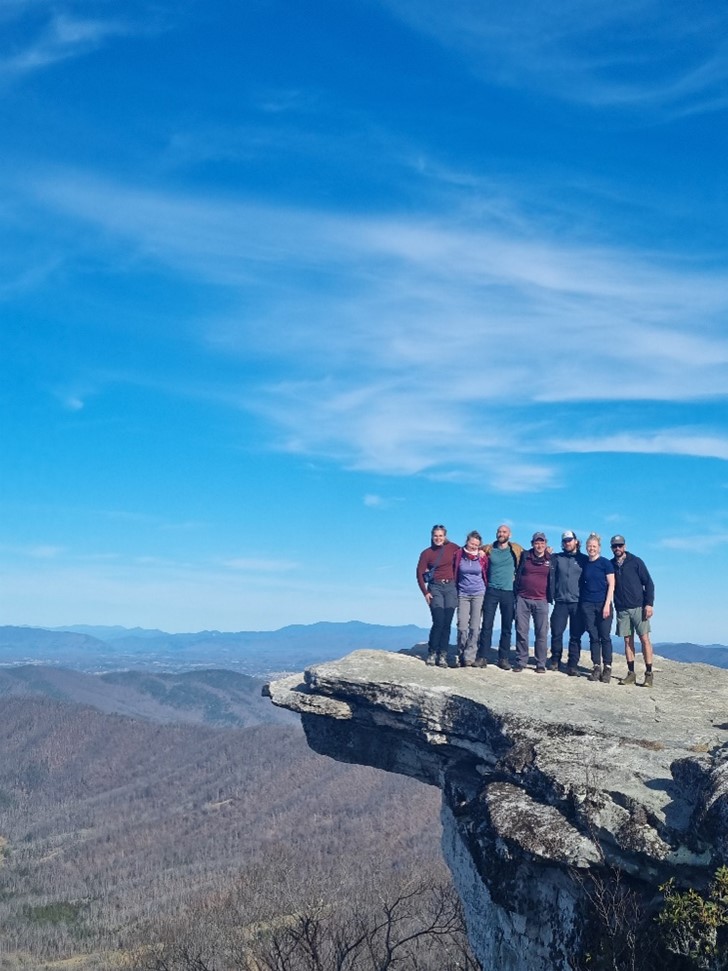
Photo credit: Morten Byskov Graversen
Wilderness Medicine Society’s Student and Resident Elective: A First-Hand Experience
Brian Laverentz, DO
The Wilderness Medicine Society’s student elective is a 4-week course of study for medical students, residents, nursing students, and physician assistant students. Residents have the option to do 2 or 4 weeks for the elective, and the objectives and detailed information about the elective can be found on the Wilderness Medical Society’s website. However, I do not want to reiterate those details and instead provide you some qualitative insight on the elective through my eyes. SPOILER ALERT! I really don’t have anything bad to say.
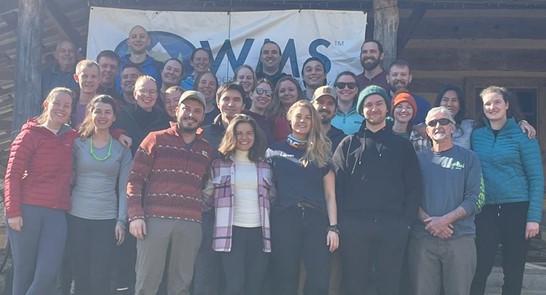
Faculty, Residents, and Medical Students stand for a group photo after wilderness first responder week. Taken by Christian Otero, MD.
Signing up for the rotation is not difficult, but there are some steps that must be taken months in advance. This includes the payment to reserve a spot in the rotation, which was $500, in addition to trip and cancellation insurance, which can average around $500. The next step is purchasing the necessary gear. A list is provided and is fairly comprehensive, which may be comforting for the less experienced. If you don’t have the necessary gear, the good news is that you will have plenty of opportunities to get most of what’s missing at base camp.
Lastly, about a month before the elective, pre-course reading materials are sent out, and the FEMA 100 and 200 courses will also need to be completed. These courses are online for free and can be completed in a single day. Additionally, for some GPS activities we were asked to download a google map of the area for offline use.
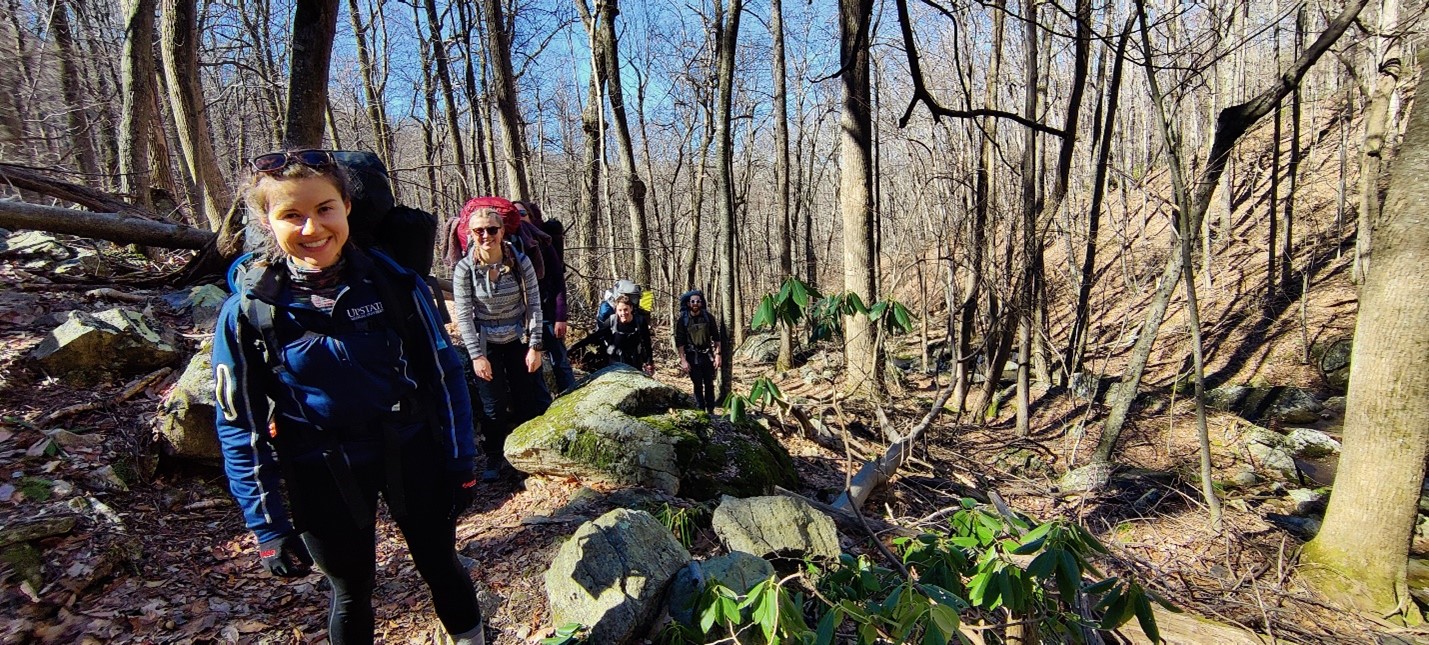
Team “Appalachian” pose with packs on during their backpacking trip to Apple Orchard Falls. Taken by Kia Lærke Madsen, 4th year Danish medical student.
I was picked up from the airport by faculty members, first stopping by Kroger for supplies and followed by lunch at Firehouse Subs before taking the 45 minute drive out to the cabin. Once there, we did some initial introductions, unpacked our bags, and took a short hike before sunset out to the bluffs. The property is quite large at around 500 acres. When we had returned from the hike, we got a fire going, ate dinner, and socialized for the remainder of the night.
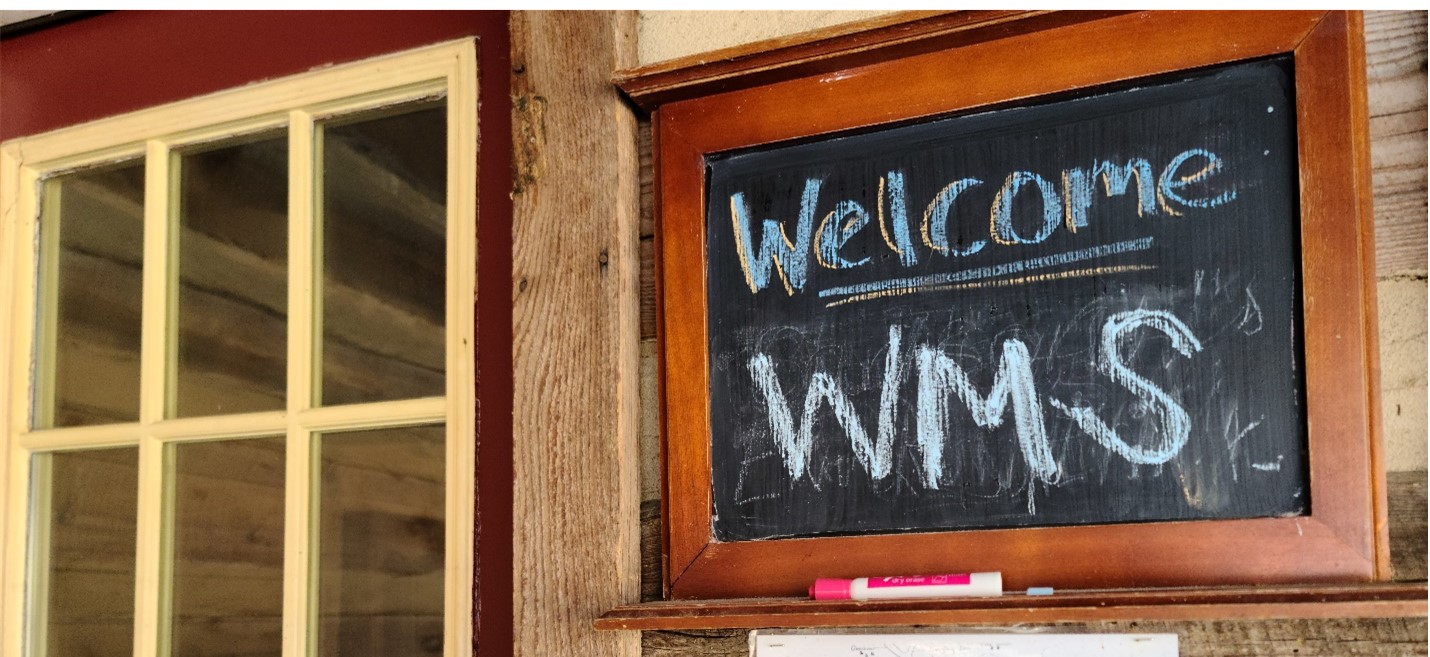
Welcome sign on arrival day at the cabin. Taken by Brian Laverentz, DO.
I know this was one of the things that felt mysterious to many. Some attendees thought they’d be living in tents for the whole month! Let me clear the air. Most of the rooms have bunkbeds and can contain multiple people and have shelving available for gear. While the room I was in could fit eight total, there were only five. There are three bathrooms to use in the cabin. There are two downstairs, split for men and women, and containing both toilets and showers, with one additional single bathroom upstairs.
There are three common spaces throughout the main cabin that are well furnished, and despite the large number of participants, there was no shortage of places to sit. During lectures the couch was a popular spot, where we’d squeeze up to four people covered in blankets directly in front of the fireplace. The cabin does have heating and A/C, in addition to a heavily used fireplace. Rest assured; you’ll be comfortable in the cabin.
Food was provided to us Monday through Friday, including breakfast, lunch, and dinner. Coffee and hot chocolate were always available, as well. Dietary restrictions were given every consideration, and refrigerator space was available to store snacks and other food for those with more limited diets. Other amenities included a washer and dryer, Wi-Fi for internet access, and cloud access to lecture files. Access to the internet was sometimes limited due to 25+ people trying to use it during peak hours.
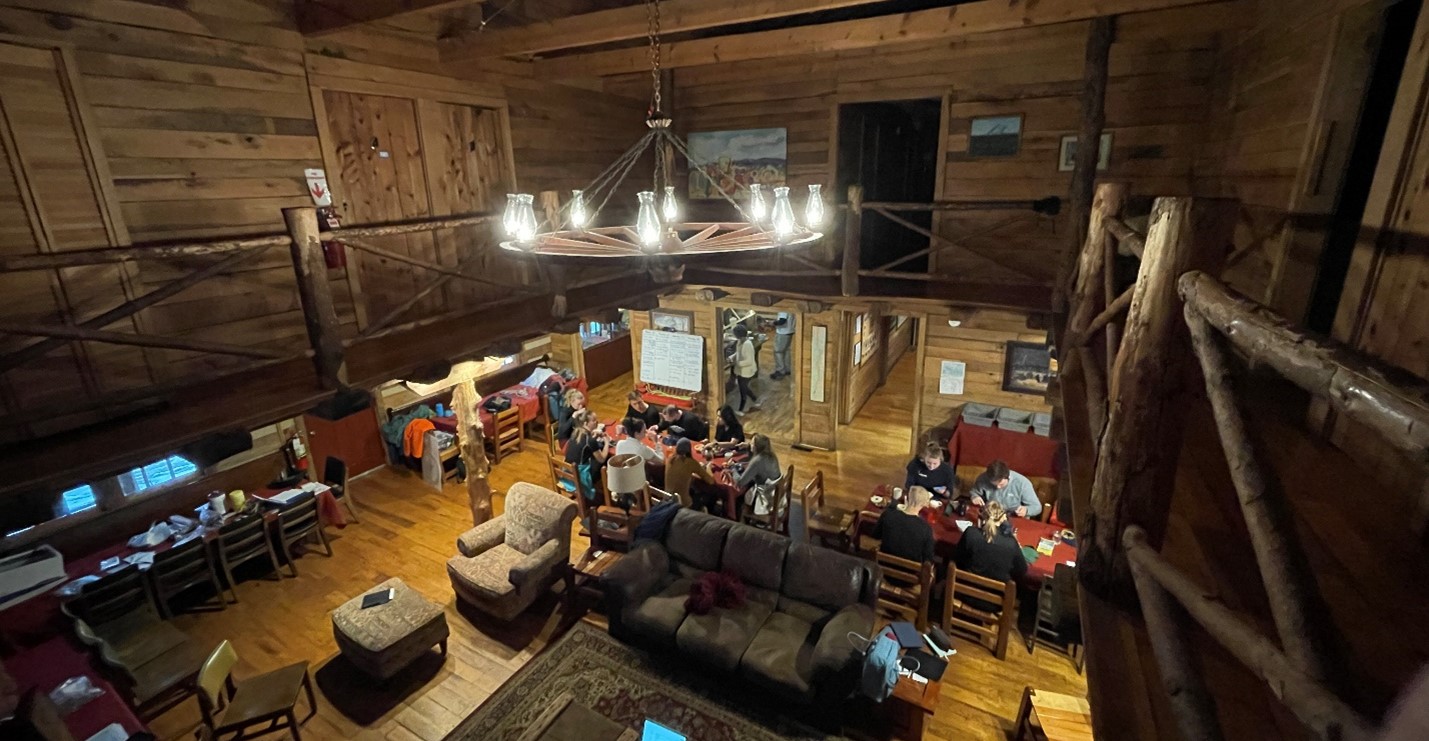
Second floor view of main cabin during mealtime. Taken by Christian Otero, MD.
Our first week was all about getting into a routine, establishing expectations, and lectures. Topics included making shelters, primitive fires, altitude physiology, introduction to backpacking, orienteering, low-angle rescue, water purification, and more. At the end of the week, we decided to test our backpacking gear out on the bluffs of the property for some overnight camping. We woke the next day to 20-degree clear skies and hiked back to the cabin. We would leave only a few hours later for a hike to McAffe’s Knob.
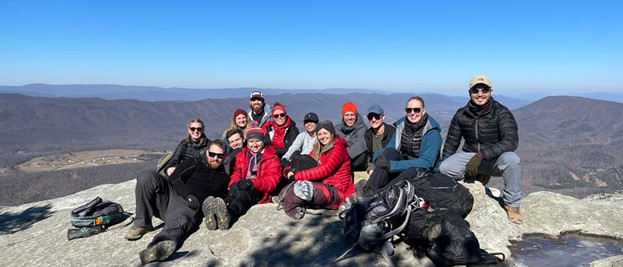
Students pose atop McAffe's Knob, one of the three points in the famous triple crown hike of the Appalachian Trail. Taken by Christian Otero, MD.
The second week was the Wilderness First Responder certification course. Guest instructors came to teach this course, and it was a highly informative and jam-packed training schedule that was all about being hands-on. We would spend hours running scenarios, debriefing on lessons learned and how to improve, then resetting to do it all over again. Each case was slightly more challenging than the previous. This culminated in a final search and rescue case where we put all the training we’d received up to that point to the test, designed to be as realistic as possible. Due to being quasi sworn to secrecy I cannot dispel the details, but I can tell you we started at 7pm and finally finished our scenario and debrief at almost 1am. We were told that one class ran until almost 4am! Don’t let this deter you from the course, though. It was one of the best training scenarios I have ever been a part of.
The weekend after the WFR certification course we were joined by the residents participating in the two-week course and hiked as a group to Dragon’s Tooth. On the way down we were notified of an EMS call for an injured hiker. Some of the students closest to the individual’s location took action and had the opportunity to put their skills to work in a real-world scenario.
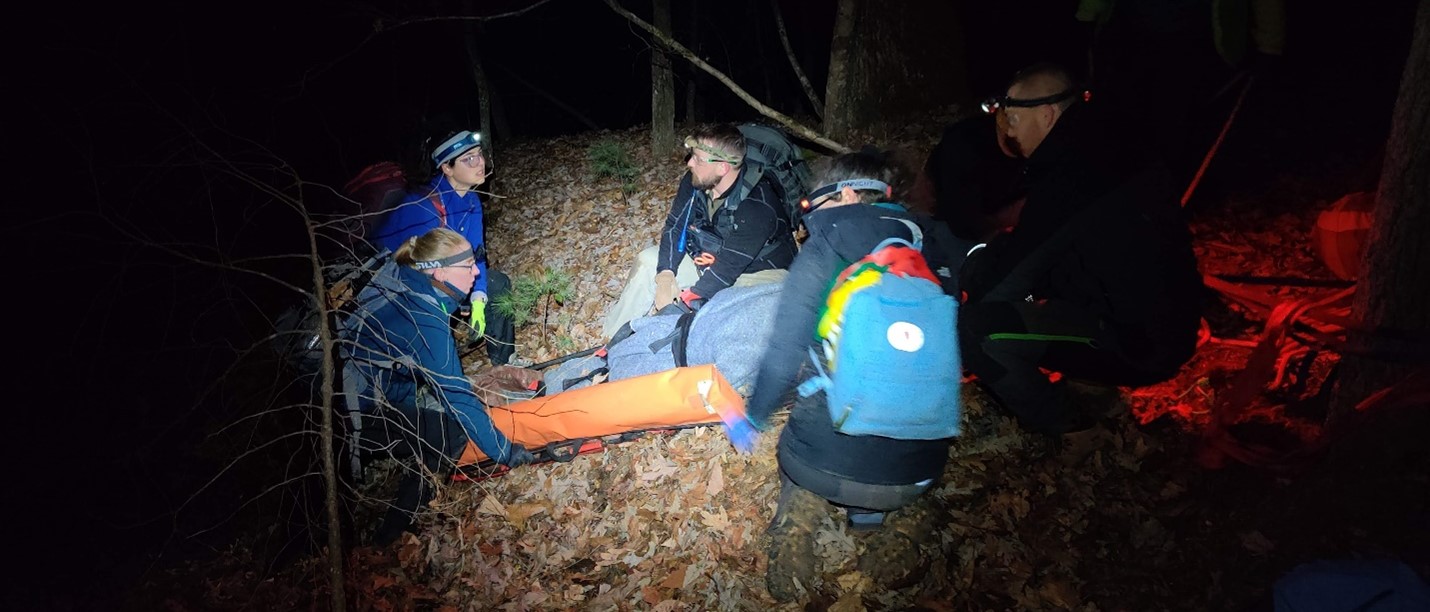
During the final scenario of the wilderness first responder course participants finish a low angle rescue with a live simulated patient. Taken by Carver Haines, MD.
Our third week kicked off with high-angle rescue training, cave exploration at New River Cave, and considerations for what a rescue in vertical terrain and confined spaces might look like. The newly arrived residents spent time in focused and integrated lectures, learning practical wilderness skills, and training the medical students on more advanced medical topics. Residents also worked side by side with students on rescue scenarios that the faculty put on. These scenarios occurred almost daily and were expanded to include field hospitals where more advanced resuscitation measures were incorporated. The capstone for the week was a MEDWAR race hosted by the residents. The final days of this week would be preparation for our upcoming backpacking trip.
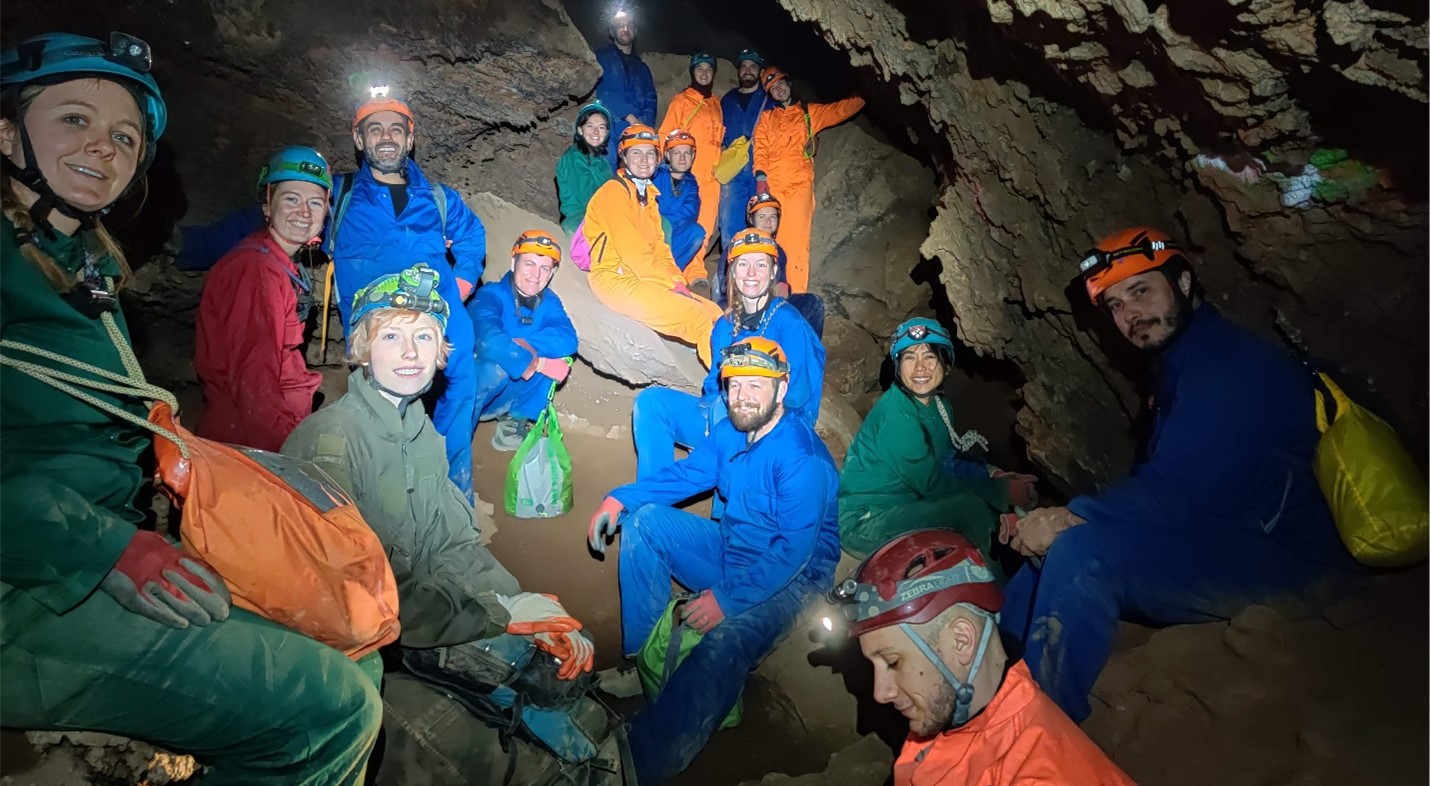
Students and faculty pose for a picture during exploration of New River Cave. Taken by Carver Haines, MD.
For the final week, we split up into groups and planned our backpacking trips to different locations based on our group’s goals. My group chose the Grayson Highlands, which included a stop at the highest point in Virginia: Mount Rodgers. I can’t speak for everyone’s experience, but our trip was amazing. I saw wild ponies, expansive mountain ranges, large pine forests, met interesting people on the trail, and most importantly, put my learned skills to real world tests. We returned from our 4-day trip for a banquet back at base camp, where speeches, fond memories, food, and libations were shared amongst all.
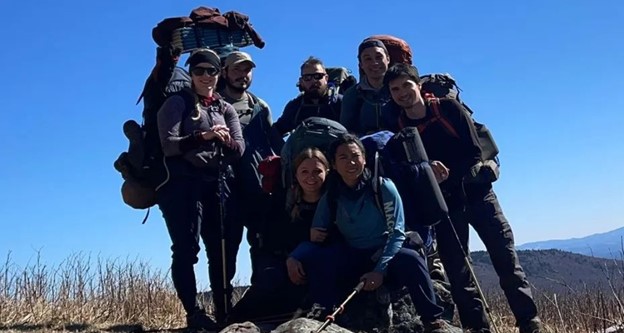
Team "The Fellowship of Grayson" take a group photo in the Grayson Highlands State Park.
No matter your prior experience in wilderness medicine, there is something for everyone here. The friends I made during this journey alone will last me a lifetime. The professional networking opportunities were some of the best. The experience and time spent in the outdoors was refreshing for my mind and soul. I walked away from this elective feeling as if I had been enveloped into the constantly growing community that is wilderness medicine. So, I suggest if you even have an inkling that wilderness medicine is for you, just do it!
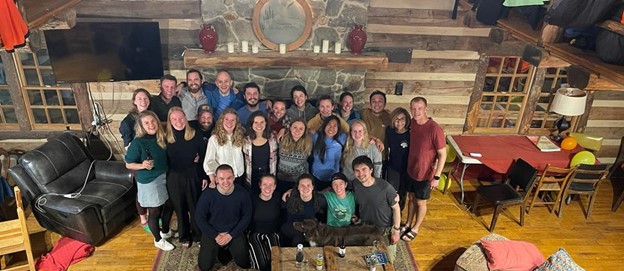
Final group photo of students, residents, and faculty on banquet night after the completion of the backpacking trip.